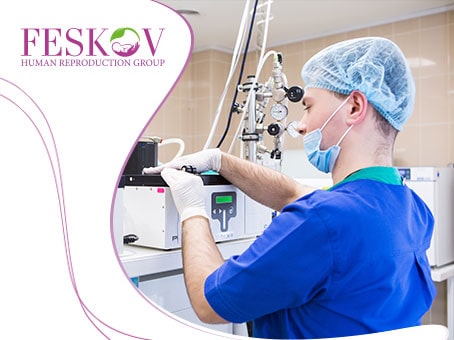
ICSI, PICSI and IMSI methods, what is the difference and differences?

The natural process of conceiving a child has not been a secret for everyone for a very long time. However, at the micro level, it is not so simple. The male reproductive cell is a spermatozoon, 50 microns in size, after entering the female vagina, it must overcome the road thousands of times larger than itself, overcome all obstacles, and then break through all the oocyte membranes and merge with it.
This requires a lot of energy and strength, so only the best specimens are capable of this feat. Today, problems with sperm, when a small number or no such cells at all, have become almost the norm. About 40% of cases of infertility are associated with the male factor. Feskov Human Reproductive Group uses reproductive services, effectively solving problems of male infertility.
Features of male infertility
Decreased sperm quality is commonly associated with male-type infertility when:
- no viable and active cells are observed;
- a lot of cells with pathologies;
- the presence of chromosomal mutations;
- sperm is not active at all.
When a man has at least one such indicator, doctors can diagnose his infertility and recommend that he undergo appropriate therapy.
At the dawn of the development of ART it looked like this. However, sometimes, even being in the same vessel, the sperm cannot penetrate the egg. Since it may be weak, with developmental pathology, with reduced activity, or have other qualities that prevent him from fertilizing the female reproductive cell.
Therefore, the specialists were able to expand the capabilities of this technique. New techniques for selecting the best representatives of sperm and manual fertilization of oocytes with them make it possible to forget about male problems.
ICSI technique
ICSI, or sperm injection directly into the oocyte, is a pioneering IVF technique that was invented by scientists reproductive specialists first. Using an electron microscope, which magnifies the picture 400-600 times, the doctor selects the hero-sperm. Thus, the specialist fixes mutations, pathologies, monitors the activity of the cell in order to fix his gaze on the healthiest specimen. Since healthy children are obtained only from a full-fledged sperm.
The selected cell is fixed with a microscopic needle, which perforates the surface of the egg and releases the sperm directly into the cytoplasm. This is how artificial insemination occurs by the hands of a doctor with all the oocytes taken from a woman.
Further, everything goes according to the IVF protocol: the cultivation of the embryo, its transfer into the uterine cavity, diagnosis of pregnancy.
Indications for the procedure:
- all causes of male infertility;
- female age over 40 years due to the increased thickness of the oocyte wall;
- unsuccessful IVF attempts;
- problems in immunology, when a woman's body perceives sperm as enemies and destroys them;
- unexplained infertility, in which the partners are all right with their health, and conception still does not occur.
The addition of ICSI to in vitro conception significantly increases the likelihood of a miracle of pregnancy and the birth of a normal baby.
Advances in technology, the emergence of even more powerful microscopes, as well as the desire of doctors to improve manipulation, have led to new research in this area. As a result, reproductologists have two more additional techniques - PICSI and IMSI.
PICSI technique
IMSI technique
IMSI, or morphologically matched sperm injection, is another addition to the ICSI process. What makes this procedure different from previous techniques is the use of an even more powerful microscope of the latest generation, with a magnification of 6,000 times.
This method became possible only after the establishment of modern magnifying technology in the service of medicine, namely mega-powerful microscopes. Now doctors observe with their own eyes not only the activity and vitality of sperm, but can also make their morphological selection.
Our Customer Service Representatives are eager to help you with whatever you need.
Thanks to the development of reproductive technologies, pharmacy and medicine in general, now, even a man with critical reproductive problems can have a child of their own. Therefore, specialists at Feskov Human Reproductive Group recommend not to give up and try all possible ways to make your family happy with a healthy own baby. A variety of programs for the cost without additional payments will help you to choose the most suitable option from Standard to VIP. However, progress cannot stand still, and perhaps even more effective and safe methods will soon appear so that all people can have their own children!
- Surrogate motherhood - how not to be deceived
- The cost of parenthood: an overview of reproductive programs from leading clinics
- Advantages of guaranteed surrogacy programs over programs with guaranteed compensation
- Disadvantages of Egg Donation - Only Truth about the Procedure
- Unique Cases of Giving Birth to Children
- How the History of Surrogacy Changed Over the Years
- Why I Chose Surrogate Motherhood with Feskov
- The First Meeting: 5 Helpful Tips for Surrogates & Intended Parents
- Pregnancy After Miscarriage: Getting Pregnant
- Surrogacy in Ukraine: Legal Aspects
- Women's Age And Fertility
- Historical Changes to Surrogate Laws in Israel
- TOP 5 surrogate clinics in Ukraine
- International Surrogacy Program Ukraine-Canada
- Why is surrogacy so expensive — what do you pay for
- 15 facts about Surrogacy
- Egg donation in Canada
- Unique Cases of Giving Birth to Children
- Private surrogacy in the UK
- Private surrogacy Australia
Join my mailing list to receive the latest news and updates
